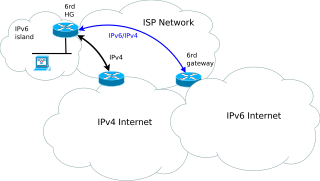How 6to4 works

6to4 performs three functions:
- Assigns a block of IPv6 address space to any host or network that has a global IPv4 address.
- Encapsulates IPv6 packets inside IPv4 packets for transmission over an IPv4 network using 6in4.
- Routes traffic between 6to4 and "native" IPv6 networks.
Address block allocation

For any 32-bit global IPv4 address that is assigned to a host, a 48-bit 6to4 IPv6 prefix can be constructed for use by that host (and if applicable the network behind it) by appending the IPv4 address to 2002::/16.
For example, the global IPv4 address 192.0.2.4 has the corresponding 6to4 prefix 2002:c000:0204::/48. This gives a prefix length of 48 bits, which leaves room for a 16-bit subnet field and 64 bit host addresses within the subnets.
Any IPv6 address that begins with the 2002::/16 prefix (in other words, any address with the first two octets of 2002 hexadecimal) is known as a 6to4 address, as opposed to a native IPv6 address which does not systematically use transition technologies.
Note that using a reserved IPv4 address, such as those provided by RFC 1918, is undefined, since these networks are disallowed from being routed on the public Internet. For example, using 192.168.1.1 as the router's WAN address would be invalid since a return packet would not be able to determine the destination IPv4 address of the actual sender.
Encapsulation and transmission
6to4 embeds an IPv6 packet in the payload portion of an IPv4 packet with protocol type 41. To send an IPv6 packet over an IPv4 network to a 6to4 destination address, an IPv4 header with protocol type 41 is prepended to the IPv6 packet. The IPv4 destination address for the prepended packet header is derived from the IPv6 destination address of the inner packet (which is in the format of a 6to4 address), by extracting the 32 bits immediately following the IPv6 destination address's 2002::/16 prefix. The IPv4 source address in the prepended packet header is the IPv4 address of the host or router which is sending the packet over IPv4. The resulting IPv4 packet is then routed to its IPv4 destination address just like any other IPv4 packet.
Routing between 6to4 and native IPv6
To allow hosts and networks using 6to4 addresses to exchange traffic with hosts using "native" IPv6 addresses, "relay routers" have been established. A relay router connects to an IPv4 network and an IPv6 network. 6to4 packets arriving on an IPv4 interface will have their IPv6 payloads routed to the IPv6 network, while packets arriving on the IPv6 interface with a destination address prefix of 2002::/16 will be encapsulated and forwarded over the IPv4 network.
There is a difference between a "relay router" and a "border router" (also known as a "6to4 border router"). A 6to4 border router is an IPv6 router supporting a 6to4 pseudo-interface. It is normally the border router between an IPv6 site and a wide-area IPv4 network, where the IPv6 site uses 2002::/16 co-related to the IPv4 address used later on. On the other hand, a "relay router" is a 6to4 router configured to support transit routing between 6to4 addresses and pure native IPv6 addresses.
To allow a 6to4 host to communicate with the native IPv6 Internet, it must have its IPv6 default gateway set to a 6to4 address which contains the IPv4 address of a 6to4 relay router. To avoid the need for users to set this up manually, the anycast address 192.88.99.1 used to be allocated. [4] It could be assigned to any number of 6to4 relay routers, so that IPv4 routing would take care of routing the encapsulated IPv6 packets to the one closest-by for forwarding onto IPv6 Internet. Due to unsolvable operational problems, this use has been deprecated. [2] [3]
Packets from the IPv6 Internet to 6to4 systems must be sent to a 6to4 relay router by normal IPv6 routing methods. The specification states that such relay routers must only advertise 2002::/16 and not subdivisions of it to prevent IPv4 routes polluting the routing tables of IPv6 routers. From here they can then be sent over the IPv4 Internet to the destination.
For a 6to4 host to have fast and reliable connectivity with a host natively using the IPv6 Internet, both the 6to4 host and the native IPv6 host must have a route to a fast, reliable and correctly configured relay server. The 6to4 host's ISP can ensure that outgoing packets go to such a relay, but they have no control over the relay used for the responses from the native IPv6 host. A variant called IPv6 rapid deployment ("6rd") uses the same basic principles as 6to4 but uses a relay operated by the 6rd user's ISP for traffic in both directions. To achieve this an address block allocated by the user's ISP is used instead of 2002::/16.






